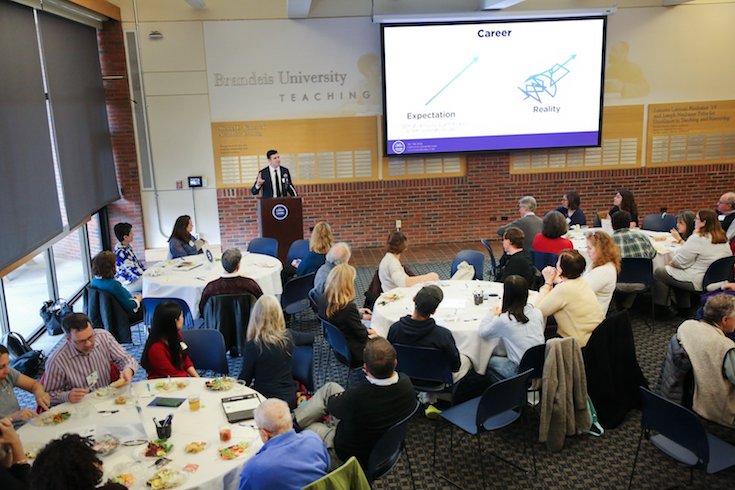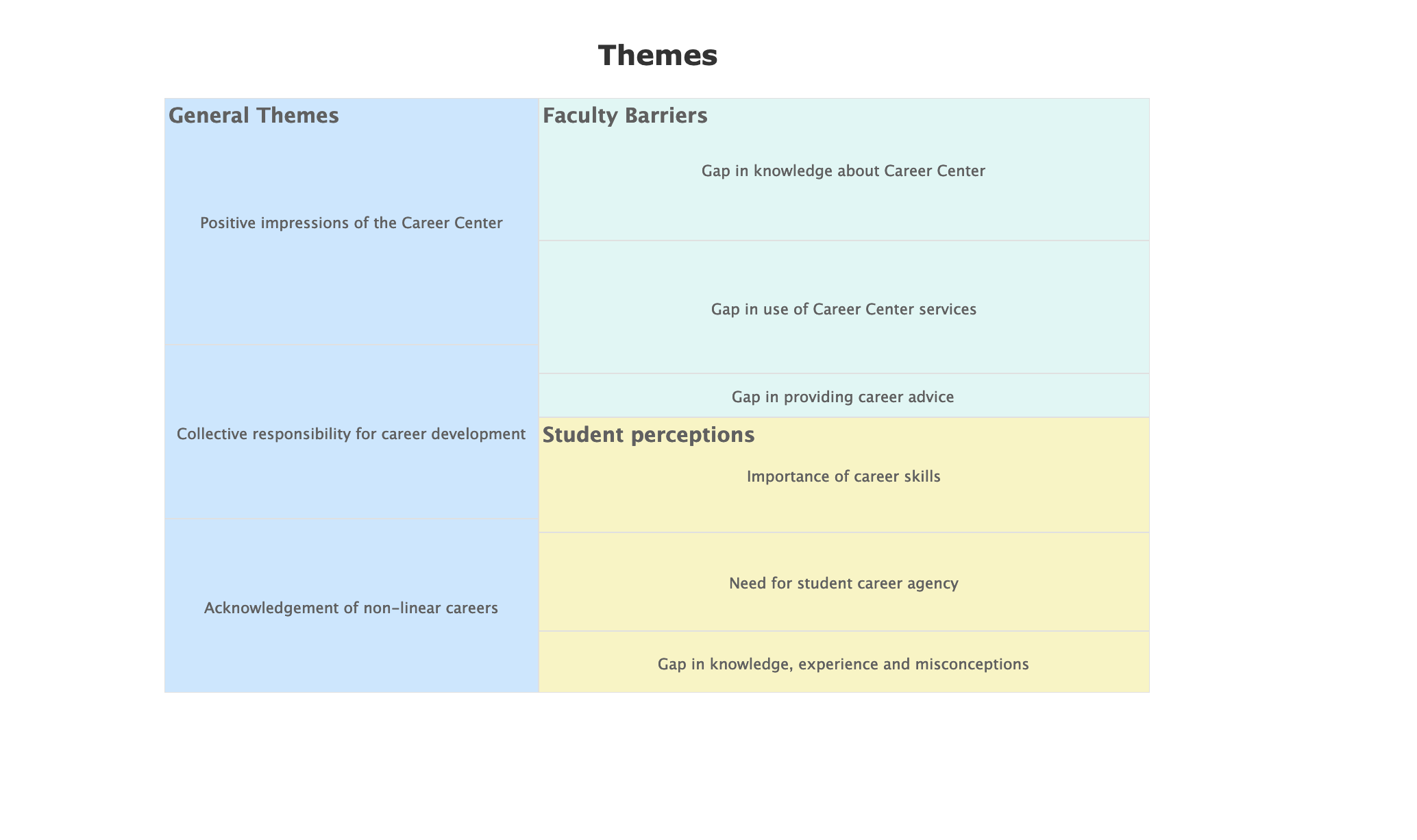Hiatt Study: Faculty Perceptions of Career

In early 2019, a research team from the Hiatt Career Center started a qualitative study of Brandeis faculty. We followed our Institutional Review Board (IRB) procedures and initiated a formal research study to ensure we were using sound research practices.
The team sought to address two research questions; how faculty perceive their role in student career development and how faculty perceive the undergraduate career center. Our key findings included that faculty had positive impressions of career services, support for a collective university responsibility for career and support of non-linear career development. Three clear next steps emerged to help us continue and expand our collaborative faculty relationships.
Approach
Hiatt utilized a bounded case study (one site, our campus) design with purposeful sampling (faculty who met the designated criteria of being full-time who taught undergraduate students) for a series of semi-structured focus groups. With approval from IRB, we followed standard qualitative research practices. In total, eight faculty attended a focus group session representing the departments of mathematics, environmental studies, psychology, classical studies, computer science, biology and economics. Participants are listed below with their name, career center engagement and tenure in their position. Some identifiers have been changed to protect the identity of participants.
| Participant Name | Career Center Engagement | Tenure in Position |
|---|---|---|
| Alex | Limited | 7 Years |
| Ann | Never | 4 Years |
| Flora | Frequently | 35 Years |
| Jiao | Limited | 11 Years |
| JJ | Never | 1 Year |
| Marcus | Limited | 3 Years |
| Paul | Limited | 17 Years |
| Zhou | Limited | 13 Years |
To help understand trends in the conversation topics, we utilized the standard qualitative research approach, Thematic Analysis (TA). As there was no indication of prior research as it relates to this study with this population, it was concluded that this pool of participants was sufficient for data analysis. Following TA, we utilized a six-step approach of transcribing data, generating initial codes, searching, reviewing and defining themes. This method was chosen to gain a rich narrative of faculty’s beliefs and perspectives on their role in student career development and their perceptions of the role of an undergraduate career center.
Results
Though the sample size for this study was small, the findings concluded that there was considerable support for career services and that messaging between the faculty and the Hiatt Career Center were aligned.
 (Accessible description: This table shows the general themes and faculty barriers in the study. The general themes are positive impressions of the career center, collective responsibility for career development and acknowledgment of non-linear careers. The faculty barriers are gap in knowledge about the career center, gap in use of career center services and gap in providing career advice. Student perceptions are importance of career skills, need for student career agency and gap in knowledge, experience and misconceptions.)
(Accessible description: This table shows the general themes and faculty barriers in the study. The general themes are positive impressions of the career center, collective responsibility for career development and acknowledgment of non-linear careers. The faculty barriers are gap in knowledge about the career center, gap in use of career center services and gap in providing career advice. Student perceptions are importance of career skills, need for student career agency and gap in knowledge, experience and misconceptions.)
Feedback
Faculty awareness and support for the career center were tied closely together with their direct experiences. Faculty-focused events they attended were mentioned most frequently in a positive light, while second-hand awareness of the career center resulted more from transactional programs such as resume building, career fairs, and interviewing which students spoke about positively to faculty.
“I have a positive impression, I think you [the center] seem driven to improve services in a number of ways. My impression was that you are very focused on making a better service for students… how you approach the guidance of students, and that you're trying to be as… as involved as possible.” - JJ
"[students] talk about it in positive terms… I really only heard from them in terms of interview prep and resume prep and jobs.” - Ann
A number of the educational programs and services, as well as the general policies on who the career center serves, were not known by faculty. The barriers of awareness and utilization were very common problems; time and faculty silos were frequently cited as obstacles.
“Usually, what happens is that students come specifically [to talk] about career… that's when [the Career Center] will come to mind. Okay, that is the place you can go to talk more. Other than that, I mean, I didn't really think much about it.” - Zhou
I couldn't say there's this event coming up or here's the name of the person that you should go talk to who knows all about this. I want to help the student in their career development when I could say here is, you know, a [career center] resource that you can go to that will help you do this.” - Alex
While faculty reported confidence in directing students to academic careers in their own field, many discussed their limited comfort or knowledge assisting students in non-academic paths outside their field.
“I don't know anything about the job market. Nothing at all. I mean, I know what the academic job market is, but most of my students are not going into academia.” - Ann
Lack of awareness is not the same as a lack of support. The majority of the faculty participants supported the University's role, and theirs, in student career development.
The University's role, "is frankly to turn out students who are going to solve problems and our future to contribute to spreading knowledge and become artistic creators and moving our society forward." - Flora
"...since they know some of their professors well, a lot of it falls on us.” - Paul
Faculty also showed an awareness of non-linear careers and the importance of transferable skills for students.
“It's not an A and then B proposition... What we need to do is illustrate that sometimes where you start your education and where you end up [is] as a winding path that has many different components." - Marcus
“I feel like they're not as aware of thinking about, like, what are the skills that I'm developing by doing this. It doesn't really matter what [students] major in, actually it matters what experiences you get excited about.” - Alex
They also saw a need for students to address larger career development issues. Many faculty members supported career agency, students' involvement in career services and early career development work.
One misconception common to many students, "I guess they often want [the career center] to get them a job, and that's not really the way it works. So, there's some frustration with students... we're really trying to get them thinking early and also learning about careers." - Flora
“...there's a reason why we're asking [students] to develop these writing skills, there's a reason we're asking [students] to develop these world communication skills, oral communication skills, and the digital literacy skills." - Ann
"One thing with advising and teaching [we are]... trying to help students see what are the skills that they're developing and how [that] could that relate to their goals. - Alex
From this detailed glimpse into faculty perceptions and beliefs, the research team created the next steps for career center staff to further deepen faculty collaboration.
Implementing Next Steps
Consistent themes emerged from the study, prompting three recommendations for next steps:
- Consider faculty as another constituent group on campus
- Describe to faculty how the career center helps students address broad career questions
- Tailor resources for faculty to assist them in career conversations
Faculty were most engaged in programs designed just for them and expressed the most need for support in assisting students with non-academic careers. We should consider faculty as another constituent group needing continual educational programming as they too have responsibilities that mirror those of both students and staff members.
Breaking down silos will require continual work. We found even faculty who are otherwise considered engaged partners are not as familiar with parts of career services functions.
Providing detailed, specific and tailored educational programming on how the career center works with students and how faculty can support students' career exploration in their fields might also yield greater faculty awareness. The Hiatt Lunch and Learn program has proven to be a useful tool for faculty engagement with many participants mentioning the impact. We should continue to offer educational programs and materials in a variety of formats and mediums to best connect with faculty throughout the semester.
Faculty in this study were supportive of career development but less knowledgeable about how the career center works with students to address larger educational issues. Specifically, how the center works with students to connect skills to careers, how we address uncertainty in choice and the value of a liberal arts education. We should address this with more tailored content for faculty on how we work to educate students and help them address the transactional issues of career services as well as the broader educational questions.
Tailored resources for faculty and creating a train-the-trainer model for them to better direct students, could help faculty work more effectively with students interested in other fields. The majority of faculty indicated they saw career development as a collective responsibility, so with that, Hiatt can provide them with additional tools to take action. They also showcased a desire to support students with these questions and so by our center making tailored resources readily available for them may be useful in approaching their conversations with students.
Lessons Learned
As with any type of qualitative research project, we acknowledge a few limitations and lessons learned. The sample size was small, and despite outreach efforts from the Dean of Students and Center for Teaching and Learning, many participants self-selected their participation by responding to a direct invitation from the career center. There may also have been the factor of researcher bias as this initiative was implemented and owned by staff members in the Hiatt Career Center who took the lead on the research. Though objectivity was the goal, there may have been the sense that other researchers could arrive at different findings. As we look to revisit this initiative in the future, we hope to enhance and grow our sample size that is also more inclusive of additional academic departments across campus.